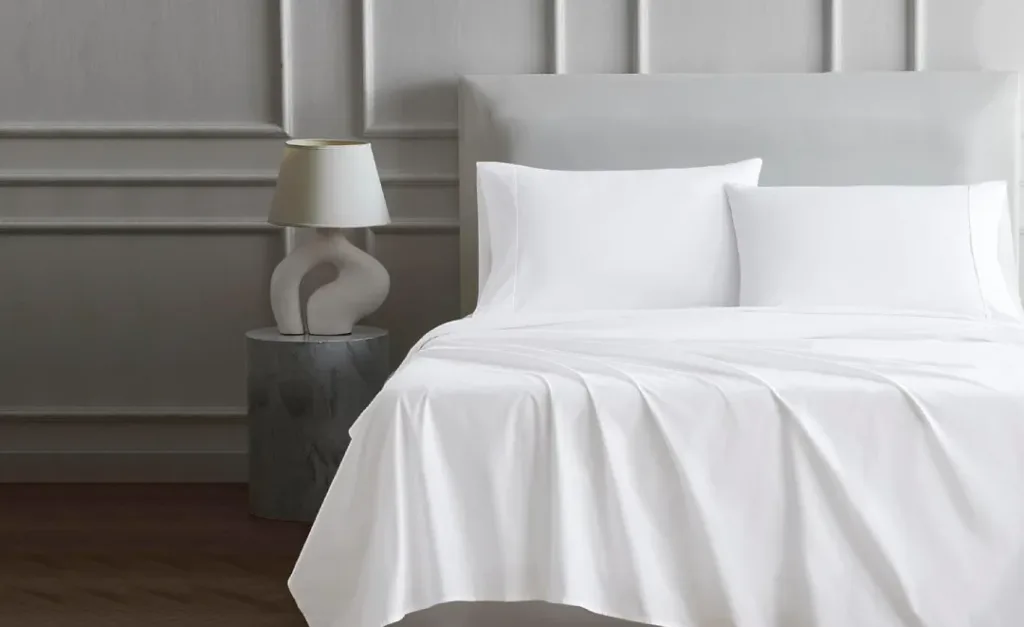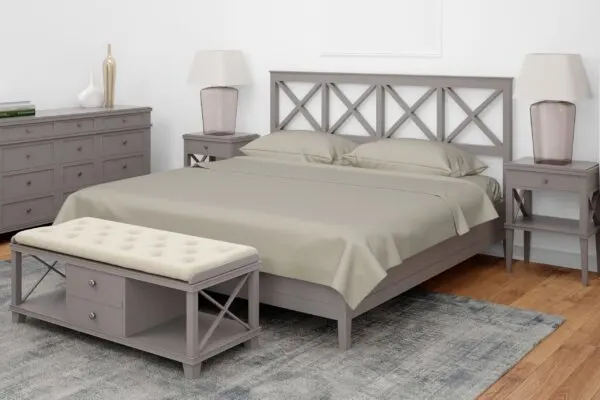How to Select the Best Bedsheets for Every Season
Introduction;
Your bedsheets are more than just part of your bedroom décor they’re the foundation of your comfort, sleep quality, and even skin health. Choosing the best bedsheets for every season isn’t just about aesthetics; it’s about aligning your bedding with temperature, humidity, and body needs.
This expert guide will walk you through the science of seasonal bedding, fabric choices, weave types, and smart care routines. Whether it’s the cool breathability of linen in summer or the cozy warmth of flannel in winter, you’ll learn how to create the perfect sleep setup all year long.

The Sleep Science Behind Seasonal Bedding
Temperature directly influences your sleep cycle. Studies show that maintaining the right sleep environment can improve rest quality by up to 30%.
In hot weather, breathable fabrics reduce night sweats and keep your body cool. In winter, thermal layers preserve warmth without overheating. Adapting your bedding seasonally prevents both discomfort and fabric wear, extending the life of your sheets by 2–3 years.
When you choose the best bedsheets for every season, you support both comfort and long-term fabric performance.
Understanding Fabric Types: Natural vs. Synthetic Fibers
1. Natural Fibers: Breathability and Comfort
- Cotton: The gold standard for comfort and versatility.
- Percale weave (200–300 thread count): Cool and crisp for summer.
- Sateen weave (300–500 TC): Smooth and warm for colder months.
- Linen: Naturally moisture-wicking and temperature regulating. Ideal for humid summers.
- Bamboo: Feels luxuriously soft and keeps body temperature about 3°C cooler.
- Flannel: Brushed cotton that traps heat, perfect for cozy winter nights.
2. Synthetic & Blended Fabrics
- Tencel™ (Lyocell): Eco-friendly, silky, and adapts to body temperature.
- Microfiber: Soft and affordable, though less breathable.
- Poly-cotton blends: Durable and wrinkle-resistant, but may trap heat.
Selecting the right fabric type is crucial when optimizing for the best bedsheets for every season — balance softness, temperature control, and longevity.
Spring: Freshness and Adaptability
Spring brings fluctuating temperatures, so flexible bedding is key.
Choose cotton percale sheets (200–300 TC) for breathable comfort during cool nights and warm days.
Pro Tip:
Add a lightweight quilt or bamboo layer for adjustable warmth.
For allergy-prone sleepers, bamboo sheets resist dust mites and pollen ideal for seasonal transitions.
Soft pastel shades like sky blue, lilac, or mint green create a fresh and rejuvenating spring atmosphere.
Summer: Stay Cool and Sweat-Free
When temperatures rise, cooling fabrics are essential for restful sleep.
Best Summer Sheets
- Linen: Absorbs 20% more moisture than cotton and allows maximum airflow.
- Bamboo: Naturally thermoregulating and antimicrobial.
- Cotton Percale: Crisp hotel-like texture that promotes breathability.
Summer Care Routine:
- Wash weekly in cold water to maintain fiber integrity.
- Skip high-heat drying it weakens threads.
- Choose light colors like white or beige, which reflect sunlight and heat.
With these tips, your best bedsheets for every season will help you stay fresh even on the hottest nights.
Monsoon Season: Humidity Control and Quick Drying
High humidity can lead to damp bedding, mold, and musty odors. During monsoon months, switch to moisture-wicking fabrics that dry fast.
Top Picks for Rainy Season
- Tencel™ Sheets: Wicks moisture 50% faster than cotton.
- Linen-Cotton Blends: Offers breathability with quick-drying properties.
Avoid:
Sateen or heavy flannel weaves they retain moisture and take longer to dry.
Maintenance Tip:
Use dehumidifier bags or silica sachets in your closet to prevent mildew buildup.
Autumn: Transitioning to Warmth and Comfort
As nights grow cooler, swap your crisp percale for cotton sateen sheets (300–400 TC). Their smooth texture provides gentle warmth without trapping heat.
Color Psychology:
Earthy tones like terracotta, ochre, and caramel promote coziness and relaxation.
Expert Strategy:
Keep a mix of cool percale pillowcases and warmer sateen ones. It allows you to adapt easily to nightly temperature swings a true hallmark of owning the best bedsheets for every season.
Winter: Maximum Warmth with Smart Insulation
Winter demands insulation and softness.
Cold-Weather Favorites
- Flannel Sheets: Double-napped texture traps warm air pockets.
- Brushed Cotton: Softer than flannel, yet warm and breathable.
- Sateen Cotton: Ideal for moderate winter climates.
Winter Optimization Tips:
- Dark shades (navy, burgundy) absorb heat and enhance coziness.
- Pair flannel sheets with a wool blanket for extra insulation.
- Pre-warm your bed with a hot water bottle 10 minutes before bedtime.
By layering the best bedsheets for every season, you’ll create a cocoon of comfort during chilly nights.
Year-Round Versatility: The All-Season Heroes
Certain fabrics work beautifully in any climate when used strategically.
Top Year-Round Options:
- Egyptian or Pima Cotton: Superior breathability and softness.
- Linen: Naturally adjusts to body temperature, cool in summer and warm in winter.
- Tencel™: Eco-friendly and adaptive to humidity.
Pro Tip:
Invest in two premium sets one linen for summer and one flannel for winter to achieve full seasonal comfort with minimal expense.
The Role of Thread Count and Weave Quality
Contrary to popular belief, higher thread count doesn’t always mean better sheets.
| Season | Ideal Thread Count | Recommended Weave |
|---|---|---|
| Summer | 200–400 | Percale |
| Autumn | 300–400 | Sateen |
| Winter | 350–600 | Flannel/Sateen |
| Spring | 250–400 | Percale/Oxford |
Myth Buster:
Sheets above 800 TC often feel heavy, less breathable, and more prone to pilling. Always prioritize fiber quality and weave type over inflated thread counts.
Color Psychology: The Science of Sleep and Mood
Colors influence both perception and body response.
- Summer: Light blues and whites cool the room visually and physically.
- Autumn/Winter: Deep colors (chocolate, plum, navy) create warmth.
- Neutral All-Year: Oatmeal, taupe, and ivory remain timeless and calming.
Experts suggest that cool-toned sheets can lower skin temperature perception by up to 2°C another reason why color choice enhances the best bedsheets for every season.
Climate-Specific Bedding Strategies
Different regions demand different bedding approaches:
- Tropical Climates: Linen or bamboo with open weave.
- Dry Regions: Cotton sateen paired with a humidifier to avoid static.
- Coastal Areas: Tencel™ sheets resist salt and mildew.
- Continental Climate: Rotate percale (summer) and flannel (winter).
Adapting to your local weather ensures consistent comfort no matter where you live.
Caring for Your Bedsheets: Maintenance for Longevity
Proper care extends sheet life by years.
| Fabric | Wash Temp | Drying Method | Storage |
|---|---|---|---|
| Cotton | Cold/Warm | Tumble dry low | Rolled or folded |
| Linen | Cold | Air dry | Flat fold |
| Flannel | Warm | Tumble dry low | Vacuum-sealed |
Bonus Tip: Store off-season sheets with lavender or cedar sachets they deter pests and add a refreshing scent.
Sustainable Sleep: Eco-Friendly Bedding Choices
Sleep sustainably by choosing natural, ethical fabrics:
- Organic Cotton: Uses 91% less water than conventional cotton.
- Linen: Made from eco-friendly flax.
- Tencel™: 100% biodegradable.
- Bamboo: Renewable and naturally antimicrobial.
Eco-conscious materials not only help the planet but also enhance comfort and reduce skin irritation.
Specialized Sleep Needs
For Allergy Sufferers: Use hypoallergenic fabrics like bamboo or Tencel™.
For Sensitive Skin: Avoid synthetic dyes; opt for organic cotton.
For Pet Owners: Choose tight-weave cotton (400+ TC) to resist fur and scratches.
Conclusion: Your Path to Year-Round Bedding Bliss
Mastering the art of choosing the best bedsheets for every season transforms your bedroom into a personal comfort sanctuary. Linen and bamboo excel in summer, cotton sateen provides warmth in fall, and flannel dominates winter nights.
By aligning fabric type, weave, and color with the changing seasons, you can achieve superior sleep quality, better skin health, and longer-lasting bedding.
Invest in comfort your body (and your dreams) will thank you every night.
FAQs
1. Can I use one type of bedsheet all year?
Yes, high-quality cotton or linen sheets adapt well to mild climates. Add layers or switch pillowcases seasonally.
2. What’s the best cooling sheet for summer?
Linen or bamboo both are moisture-wicking and naturally cool.
3. How can I keep sheets fresh during monsoon?
Use quick-drying fabrics like Tencel™ and store sheets with silica sachets.
4. Are flannel sheets too warm for mild winters?
Not necessarily. Choose brushed cotton for moderate warmth without overheating.
5. What’s the most durable seasonal rotation?
Summer: Linen → Autumn: Cotton Sateen → Winter: Flannel → Spring: Percale.









Add comment